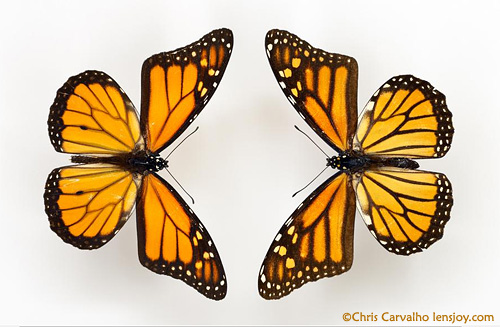







Why Butterflies Matter

Monarch butterflies, threatened in the USA, Canada, and
Mexico.
Male at left, female at right.
I get this question a lot when talking about butterflies while I'm out in the field. People ask, "Why are butterflies important? If we lost them, would it matter?" Yes, it would matter a lot. There are many things we don't yet understand about butterflies, and the useful things we've discovered so far are helping to improve our lives in surprising ways. If we allow more species to die out, we may lose a valuable solution to an important problem for humanity. Below are just a few discoveries; we've just scratched the surface.
| They are a signal of the health of our environment. Butterflies are highly sensitive to insecticides, habitat loss from non-native plants and overdevelopment. When they are absent, there is something that needs to be corrected in our surroundings. If you have butterflies in your yard, it is likely safe for you and your children. | |
| Butterflies employ successful strategies that use pheromones and plant toxins for protection from predators. They can teach us about sources for new drugs, repellents, and insecticides that are natural and safer than those we use now. | |
| They teach us how to restore habitat. Efforts to protect the Oregon Silverspot, Monarch, and Fender's Blue have taught biologists much information on what makes up a healthy ecosystem. Without the butterflies to guide us, the puzzle is a lot harder to solve. | |
| Their flight (energy use per unit mass) is far more efficient than our most advanced aircraft designs. We are learning how to employ deformable control surfaces to enhance efficiency, much the way that butterflies do. Their wing scales are the subject of research into advanced materials to manipulate light and collect solar energy. | |
| The wing scales do more than provide color. Researchers report that the texture repels water better than smooth surfaces and may lead to improved materials for waterproofing (1). It explains how the blue morpho and other species stay dry in tropical rainforest. Reducing water adhesion through textured surfaces could also improve aircraft efficiency and lessen ice buildup and the need for de-icing fluid, a water pollutant. | |
| As the native range of butterflies changes, we learn more about the effects of climate change and development, helping us to take corrective steps before it's too late. | |
| Butterflies use glycerol and sorbitol in their blood to protect them from winter cold. These chemicals are used as a cryoprotectant to prevent damage to tissues from freezing in scientific and medical applications. | |
| A chemotherapy drug called Alimta is used to treat certain kinds of non-small cell lung cancer. The core of the molecule, called pterin, is closely related to a compound found in wing pigments in butterflies (2). | |
| The butterfly's compound eye is not well understood. Originally thought to be primitive, new information indicates it is a sophisticated visual system. It's being studied to understand how it works and may lead to advances in optics and imaging. | |
| The European meadow brown butterfly has important antibacterial activity against staph bacteria. It's being studied for treating antibiotic-resistant bacterial strains. | |
| Japan's pale grass blue butterfly has been found to be very sensitive to radiation exposure in the area where the Fukushima nuclear accident happened in 2011. Genetic damage from the radiation is inherited and reduces survival of subsequent generations. By studying this species, we may learn differences that help us understand how DNA repair works in less sensitive species, including humans (3). | |
| Each late summer generation of monarch butterflies migrates thousands of miles from Canada or the USA to Mexico and California. Amazingly, this generation has never been to the overwintering sites, yet they find their way. If we can understand how this is done, it could lead to navigation methods that are robust and don't require advanced technology such as GPS that fail in geomagnetic storms. | |
| They are beautiful. They get us out into our yards and into nature to see them up close, providing happiness, fascination, and relief from stress. They symbolize peace, joy, and freedom, important human values. |
1 Bixler, Gregory D. and Bharat Bhushan . "Bioinspired rice leaf and butterfly wing surface structures combining shark skin and lotus effects." Soft Matter, (2012): ,8. 11271-11284. Print.
2 Taylor, Edward C. "From the Wings of Butterflies: The Discovery and Synthesis of Alimta." Chemistry International, (2013): 8.5, 4-8. Print.
3 Nohara, Chiyo et al. "Ingestion of radioactively contaminated diets for two generations in the pale grass blue butterfly." BMC Evolutionary Biology (2014): 14:193.
